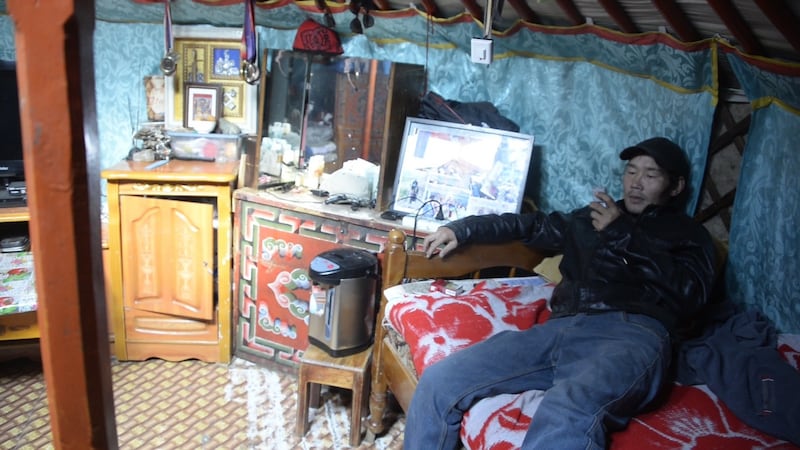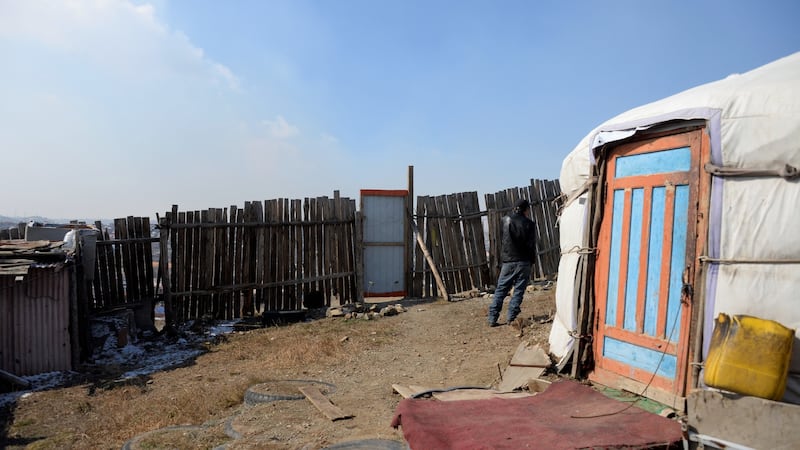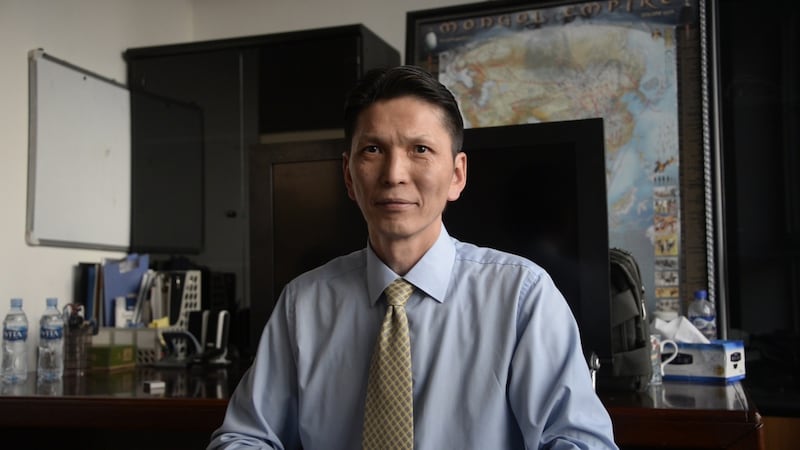At the end of a bright autumn day in the Mongolian capital Ulaanbaatar, it is -12 degrees. As the evening falls, thousands of chimneys in the city begin to release thick and hot smoke, changing the colour of the sky to a dusty pink.
Standing at the top of a hill on the outskirts of the city, Bayar Deegi (46), a successful lawyer-turned-inventor, is keen to show how the black smog swallows his home town. Thousands of households will have to burn low-quality coal until the morning to cope with the temperatures, which will to drop to -15 degrees at night.
Even with an air pollution mask, the combination of the cold and smoke is difficult to bear. The toxic fumes dance in the air with the wind and create a grey hue around the street lamps.
“It’s still the warm season, so the cold and air pollution aren’t too bad at the moment,” Deegi says, his face betraying no hint of sarcasm. “You should come back in January to see it at its worst – when people living in these poor neighbourhoods don’t have anywhere to dispose of the ash and leave it in the streets. The ash flies with the wind. That’s when Ulaanbaatar turns into a massive ashtray.”
Ulaanbaatar, which was founded in the 17th century as a nomadic Buddhist monastic centre, literally means “The Red Hero” in the Mongolian language, a reference to country’s Soviet past. However, these days, many residents refer to it as Kharbaatar, meaning “The Black Hero” during the winter months due to the alarming levels of air pollution. Deegi believes this pollution is to blame for the deaths of many people who were dear to him.
“My sister-in-law died from lung cancer a year ago,” he said, his voice unable to hide his grief. “She lived only three months after the diagnosis.”
“My sister’s father-in-law also recently died from lung cancer. Then, a year or two ago, her friend died from lung cancer,” he said. “These were all healthy people. They didn’t drink or smoke. They didn’t have bad habits. They only lived in Ulaanbaatar.”
These days, everyone who lives in the capital knows someone who has lost their lives to lung diseases, Deegi adds.
Urban migration
Ulaanbaatar is the world's coldest capital, experiencing temperatures as low as -40 degrees in the winter months. Half of Mongolia's three million people live in the capital, as the migration from rural to urban areas has soared since the USSR dissolved in the 1990s.
Although the Mongolian economy grew at a fast pace afterwards and this landlocked nation emerged as a vibrant democracy, a third of country's population still live below the poverty line.

Almost 40 per cent of Mongolia’s population
[ is dependent on animal husbandry and rain-fed agriculture for its livelihoodOpens in new window ]
. However, according to the 2014 Climate Change Risk Index,
Mongolia
is
[ the eighth most vulnerable country in the world Opens in new window ]
to the impacts of extreme weather: climate change gradually turns winter conditions harsher, thus making it almost impossible for many pastoral communities to survive.
Every year thousands of nomadic herders lose their animals to a natural disaster unique to Mongolia known as dzud. In 2016 more than one million animals were killed by dzud, forcing the herders to seek new opportunities in the capital.
The combination of climate change, peaking population, limited infrastructure and heavy dependence on coals for up to eight months of the year have created the one of the worst cases of air pollution in the world.
First the weak ones started to die and we hoped the rest would survive, but they didn't
Levels of particulate matter in the air have risen to almost 80 times the World Health Organisation recommended safety level – and to five timeworse thans the level of heavily-polluted Beijing.
Natural beauties
Mongolia has been described as the "Land of the Eternal Blue Sky". This East Asian nation, sandwiched between Russia and China, boasts world-famous natural beauties such as vast steppes, deserts, mountains and taiga. However, in many of Ulaanbaatar's shanty towns, the harsh sunlight glistens not on pristine rivers or lakes, but plastic bottles and broken glass on the ground.
Byamba Enkhbat, a 39-year-old father of three and a former nomadic herder, lives in such a neighbourhood. The winter of 2007 was a particularly harsh one for many nomadic families such as Enkhbat’s who lived near the Khosvgol Lake in the northern part of the country, close to the Russia border. The dzud of that year reduced Enkhat’s family from being well-off owners of more than 100 goats and sheep to having nothing.
“First the weak ones started to die and we hoped the rest would survive, but they didn’t,” Enkhbat says. “There was too much snow, so they couldn’t eat. They got skinnier by day and died one after the other. By the time the winter was over, we had lost all our animals.”
After losing his livelihood, Enkhbat had no choice but to relocate his family to the capital, where they live in a traditional nomadic yurt known as a “ger” in Mongolian, as they cannot afford to live in an apartment. Enkhbat now works as a manual labourer in a block factory, while his wife is a janitor at a school.
Both are on the Mongolian minimum wage of 240,000 Mongolian Togrogs (€83) a month.
There are more than 800,000 people who, like Enkhbat, live in the poor outskirts of Ulaanbaatar, colloquially referred as "ger districts".
With an estimated 25-40 per cent of Mongolia’s three million people
[ still leading a pastoral and nomadic lifeOpens in new window ]
, this vast country is
[ the least densely populated nation- state in the world Opens in new window ]
. While the smoke coming from a lone ger or two in the countryside during deep winter might be insignificant, Ulaanbaatar cannot carry the burden of thousands – when the migration from the countryside to the capital continues at a rapid rate.
‘It’s unbearable’
Oyuntsetseg Yanjin, a 40-year-old single mother of two daughters, moved to the ger districts of Ulaanbaatar only a month ago from the countryside, also from the Khosvgol Lake region.
I'll find a way to survive. I cannot live like this here. I feel very depressed about the smoke
Yanjin lost her animals, 90 sheep and goats, to the dzud in 2000. However, as a struggling single mother, she didn’t have the means to immediately move to the city. Instead, she and her daughters spent many years living with her relatives without a source of income and dreamed of coming to the city.
“My older daughter was accepted by an engineering faculty in Ulaanbaatar this year,” she said, beaming with pride. The family finally came to Ulaanbaatar after many uncomfortable years living with others and Yanjin found a job as a dishwasher to support her daughters’ education. Although this was the moment they had waited for for a long time, Yanjin is deeply disappointed in city life, even though she hasn’t even lived through the worst months of air pollution.

“Life is not that great in the city,” she says, sitting on the ground in her ger and shaking her head. “The smoke is just too much. It’s unbearable. I was very healthy living in the countryside – although it’s much colder there. Since we came to Ulaanbaatar, we have all been ill constantly. I spent half of my salary on medicine.”
“As soon as my daughters graduate, I am going back to the countryside. I’ll find a way to survive. I cannot live like this here. I feel very depressed about the smoke,” she adds.
"Poverty is hierarchical, smog is democratic," prominent sociologist Ulrich Beck famously said in 1992, in the aftermath of the Chernobyl disaster of 1986. Fast forward to 2017, and many of the ger district residents of Ulaanbaatar would disagree with Beck. The smog not only makes the life much harsher for the Mongolian urban poor, but also perpetuates the cycle of poverty for many families by preventing them from making the most of the opportunities available to them. In the ger districts, access to education epitomises this.
Small children – or anyone who is shorter than 1.5 meters, really – experience the worst form of air pollution
Oyunchimeg (8) has to walk two hours a day to get to her school and back. The colder morning and early evening hours, which is when the intensity of smog is often the highest in the ger districts, coincides with the hours thousands of children such as Oyunchimeg walk to the school.
“When it’s winter and smoky, I hate walking,” she says. “If the cold or smog is too bad, some days I skip the school.”
“Sometimes we cannot even see the traffic lights. We cannot tell if it’s green or red,” she added.
“Small children – or anyone who is shorter than 1.5 meters, really – experience the worst form of air pollution,” Deegi says. “In deep winter, they inhale all the ashes rising from the ground.”
Like thousands of peri-urban families, Oyunchimeg’s family burns coal at home. So for Oyunchimeg, there is no respite – whether at home or going to school, she breathes heavily polluted air.
Healthcare costs
According to the research of the Ger Community Mapping Centre, an urban development NGO that uses data and mapping techniques to highlight the issues of ger districts, the number of schools in the these districts is severely inadequate for the number of residents. With the lack of access to public transportation, a peri-urban child might end up spending several hours a day just walking to the school.
Furthermore, as most gers don’t have access to water resources, families have to bring water from wells. Since fetching water is traditionally a child’s job in Mongolia, this maximises children’s contact with the polluted air, which also contaminates the water resources that families use.
Even though air pollution is much more prominent in the lives of the urban poor, Mongolian politicians living in cleaner districts are well aware of the issue. In an effort to address it, the government launched a competition in 2014 to find innovative solutions.

Bayar Deegi won the competition with his invention of a lighter to reduce coal smoke by 80 per cent. Motivated by his passion to innovate and reduce the impacts of air pollution on his fellow residents, Deegi was occupied with this product any moment he was not practising law, and he spent $200,000 developing it using his own savings.
The government had promised to grant $2 million to the winner of the competition to develop the product. Yet, soon after winning, Deegi received a letter from an official with an apology, stating that the government wouldn’t be able to provide the promised $2 million.
"I just don't understand," he says, showing the letter to The Irish Times. "My product could save millions of dollars in healthcare costs. It could save many lives and provide a better future for children."
According to the World Bank, if the air pollution in Ulaanbaatar was reduced by 50 per cent, the country would save $19 million to $38 million in healthcare costs. However, Deegi still doesn't think the government prioritises this pressing issue as much as it should.
“If we don’t curb the air pollution,” he says, “We’ll soon have to spend all our money building hospitals specially for treating lung diseases.”
This article was supported by a grant from the Simon Cumbers Media Fund



















